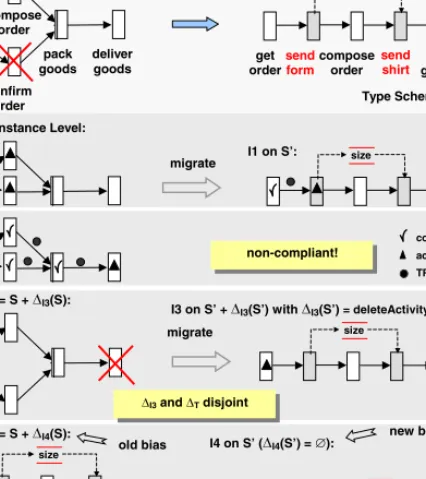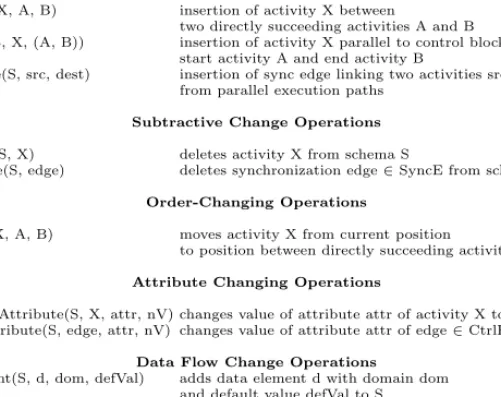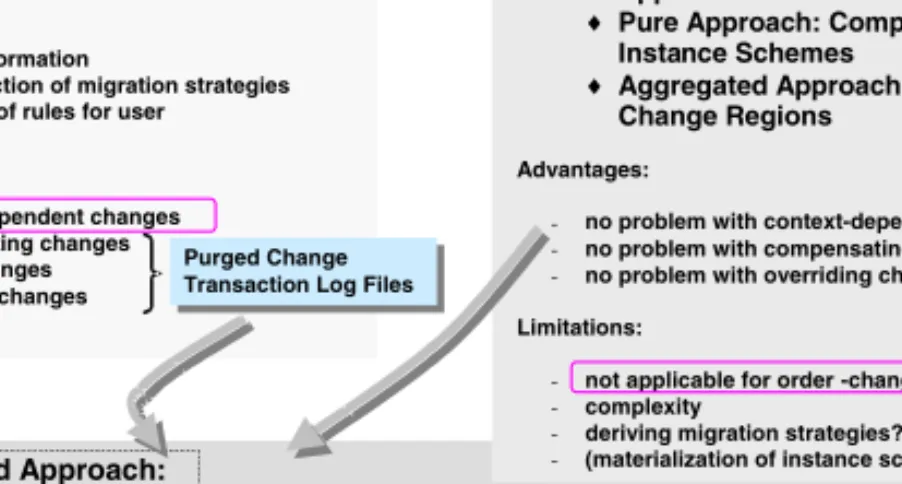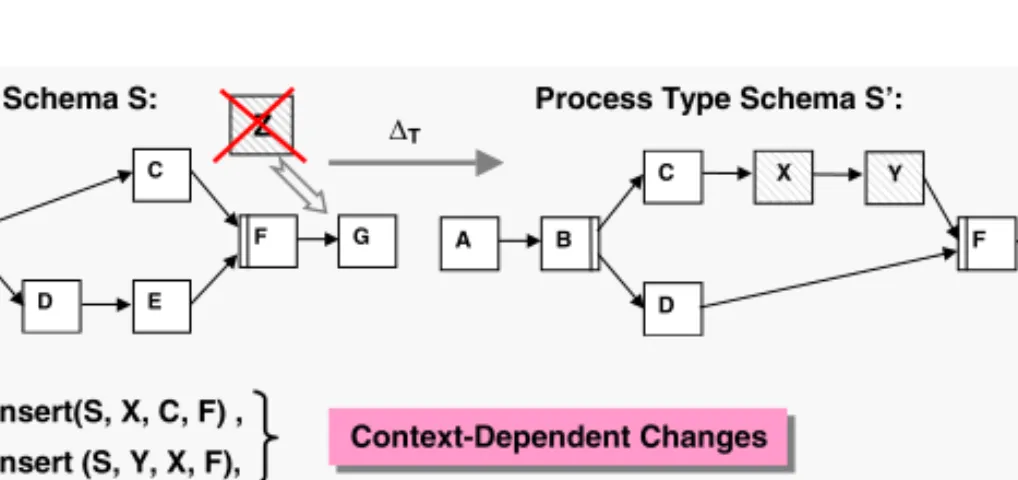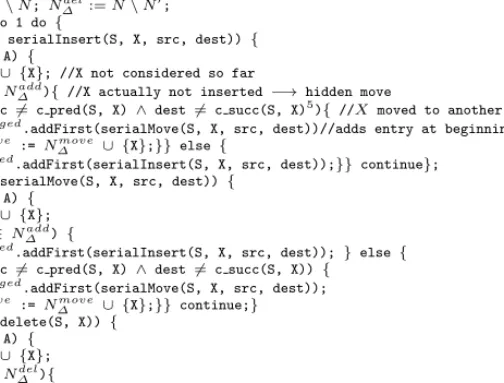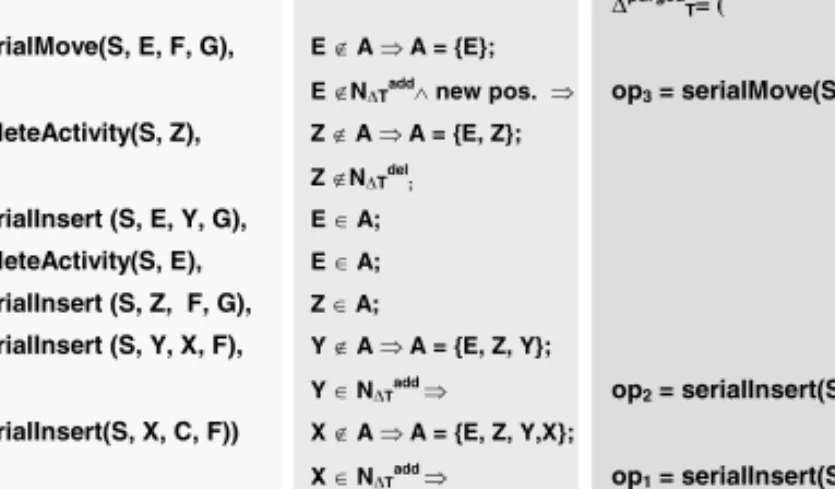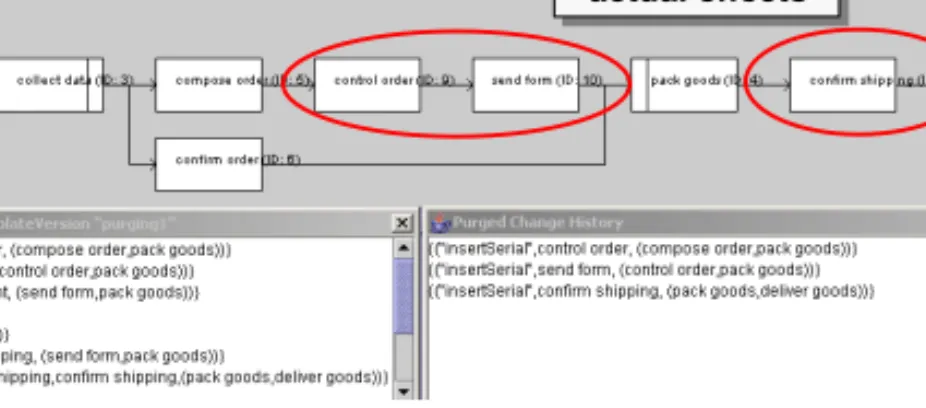Challenges, Solutions, Applications
Stefanie Rinderle, Manfred Reichert, and Peter Dadam University of Ulm, Faculty of Computer Science,
Dept. Databases and Information Systems {rinderle, reichert, dadam}@informatik.uni-ulm.de
Abstract. Adaptive process–aware information systems must be able to support ad–hoc changes of single process instances as well as schema modifications at the process type level and their propagation to a col- lection of related process instances. So far these two kinds of (dynamic) process changes have been mainly considered in an isolated fashion. Es- pecially for long-running processes, however, it must be possible to ade- quately handle the interplay between type and instance changes as well.
One challenge in this context is to determine whether concurrent process type and process instance changes have the same or overlapping effects on the original process schema or not. Information about the degree of overlap is needed, for example, to determine whether and – if yes – how a process type change can be propagated to individually modified process instances as well. This paper provides a formal framework for dealing with overlapping and disjoint process changes and presents ade- quate migration strategies depending on the particular degree of overlap.
In order to obtain a canonical representation of changes an algorithm is introduced which purges change logs from noisy information. Finally, a powerful proof-of-concept prototype exists.
1 Introduction
To stay competitive at the market for companies it becomes more and more important to adequately support their business by process–aware information systems (PAIS) [1]. Doing so it is not sufficient to implement business processes only once and to let the PAIS then run eternally without any adaptations. In fact the ability to quickly react to market changes or exceptional situations by appropriate process changes is key to success [2,3,4,5,6,7]. Basically, in a PAIS changes can take place at two levels – theprocess type or the process instance level. Process type changes become necessary, for example, to adapt the PAIS to optimized business processes or to new laws [8,9]. In particular, applications supporting long-running processes (e.g., handling of leasing contracts or medical treatments) and the process instances controlled by them are affected by such type changes [8,9]. As opposed to this, changes of single process instances have
This work was done within the research project “Change management in adaptive workflow systems”, which is funded by the German Research Community (DFG).
R. Meersman, Z. Tari (Eds.): CoopIS/DOA/ODBASE 2004, LNCS 3290, pp. 101–120, 2004.
c Springer-Verlag Berlin Heidelberg 2004
deliver goods get
order compose
order
confirm order
pack goods send form send shirt
size
compose order
pack goods
deliver goods send
form
send shirt size
get order
size
send form
send shirt size
size
Process Type Level:
Type Schema S:
Type Schema S’:
Process Type Change
'T = ( serialInsert( S, send form, collect data, compose order), serialInsert(S, send shirt, compose order, pack goods), deleteActivity(S, confirm order), addDataElement(S, size), …)
Process Instance Level:
I1 on S: I1 on S’:
I2 on S:
I3 on SI3 := S + 'I3(S):
I3 on S’ + 'I3(S’) with 'I3(S’) = deleteActivity(S, pack goods)
I4 on SI4 := S + 'I4(S):
I4 on S’ ('I4(S’) = ):
non-compliant!
completed activated TRUE_signaled
size
'I3 and 'T disjoint
'I4 and 'T overlap, more precisely 'I3 and 'T equivalent migrate
migrate
migrate
unbiased biased old bias
new bias
Fig. 1.Process Type and Instance Changes (Example)
often to be carried out in an ad-hoc manner in order to deal with an exceptional situation or evolving process requirements [8,9].
Process type changes are handled by modifying the respective process schema. Very often it is desired topropagate a process type change to related process instances as well. Process instances for which this is possible are called compliant, i.e., they can bemigratedto the new process schema [3,10]. Adapting a single process instance during runtime, in turn, logically results in an instance- specific schema (i.e., aprocess instance schemadiffering from the original schema this instance was created from). In the following, we call such individually mod- ified process instancesbiased(e.g., instances I3 andI4 in Fig. 1).
Currently there are only few adaptive process management systems (PMS) which support both kinds of changes in one system [7,11]. All these PMS have in common that once an instance has been individually modified (i.e., it possesses an instance-specific process schema due to an ad–hoc change), it can no longer benefit from process type changes; i.e., changes of the schema they were originally
created from. However, doing so is not sufficient in many cases, especially in connection with long-running processes as we have learned from several case studies within medical and automotive environments. In order to come to a complete solution, therefore, it must be possible to propagate process schema changes are carried out at the type level to biased instances as well.
When analyzing the interplay between process type and process instance changes we are faced with several challenges. In [8] we have already discussed the problem ofstructural and state–relatedconflicts that may arise when prop- agating a process type change to a biased process instance. Structural conflicts between type and instance changes, for example, may lead to deadlock–causing cycles or incomplete input data for activity executions [8].
Another fundamental issue not treated so far concerns the handling of over- lapping type and instance changes; i.e., the handling of concurrent changes1on a process schema that partially have the same effects on this schema. In this paper we give insights into fundamental challenges and solution approaches for coping with suchoverlappingchanges. One example is depicted in Fig. 1 where process type change ∆T and process instance change ∆I4 (of instance I4) both insert activitiessend form and send shirt (into schema S). Propagating type change
∆T to instance–specific schemaSI4 would therefore lead to multiple insertion of the same activities. Usually, this would not correspond to the user’s intention who, for example, has already anticipated a process optimization by an ad–hoc modification at the instance level. Furthermore ∆T and ∆I4 both delete the same activityconfirm order. As a consequence∆T actually could not be applied toSI4 sinceconfirm orderis not longer present.
One prerequisite to adequately deal with such cases is to effectively detect whether (concurrent) process type and process instance changes overlap. An- other challenge is to correctly migrate biased process instances to a modified type schema even if the instance–specific changes overlap with the process type change. Basically the problem is that the current representation of the instance–
specific schema, which is based on original schemaS plus bias∆I(S), must be transformed into a representation based new schemaS plus bias∆I(S). Doing so offers several advantages: IfI is actually re–linked toS it can benefit from further process optimizations ofS. Furthermore, reassigning instances to their actual schema version contributes to an optimal management and redundancy–
free storage of process schemes and instances. Looking again at instanceI4from Fig. 1 we can observe that∆T and ∆I do exactly the same, i.e., they have the same effects on the original process schema S. We therefore call them equiva- lent. For the above reasons, for equivalent changes a desired migration strategy would be to abstain from any propagation of∆T onI4but to re–link or migrate I4 to S. In the latter case, representation of I4 onS would no longer require maintenance of an instance–specific change, i.e., ∆I(S) =∅(cf. instanceI4 on S in Fig. 1). Assume now that an additional activity send reminder has been
1 In the following, we assume that certain instance–specific changes took place before the process type change occurs. Nevertheless, we call such changes concurrent since they work on the same original process schema.
inserted into I4. Then ∆T and ∆I4 would no longer be equivalent but ∆T be subsumed by ∆I4. For this case an adequate migration strategy is to migrate I4 toS (i.e., to re–linkI4 to S) but to further maintain the insertion ofsend reminderas instance–specific change∆I4 based onS. We conclude that for any adaptive PMS it becomes necessary to detect whether process type and process instance changes overlap, and to also determine thedegree of overlap. This, in turn, is fundamental in order to apply adequate migration strategies.
In this paper we provide fundamental definitions fordisjoint,overlapping, and equivalentprocess changes. Doing so is important in order to be able to provide adequate migration strategies. We illustrate this by means of selected scenar- ios. Based on formal definitions for disjoint and overlapping process changes we discuss different approaches for detecting them. Therebystructural, opera- tional, and hybrid approaches are presented and estimated along their specific strengths and limitations. We derive an adequate approach to detect to which degree concurrent process changes overlap. This approach comprises a sophisti- cated method topurgeunnecessary information (noise) from change transaction logs, i.e., we aim at finding a canonical respresentation of change transaction logs.
Such noise within change logs, for example, may result from mutually compensat- ing changes. Furthermore, taking purged change transaction logs the necessary information to decide on the degree of overlap between concurrent changes is extracted. Altogether, this method provides the basis for being able to apply adequate migration strategies for any kind of biased instance.
The remainder of this paper is organized as follows: In Section 2.1 we shortly introduce WSM Nets as the process meta model taken to illustrate the pre- sented results. The formal framework – definitions for disjoint, overlapping and equivalent changes – as well as migration strategies are provided in Section 2.2.
In Section 3 we discuss different approaches for detecting the degree of overlap between process type and process instance changes and a method to purge noise from change transaction logs in Section 4. We close with a discussion of related work in Section 5 and a summary in Section 6.
2 Disjoint and Overlapping Process Changes
In this paper, we exemplarily use WSM Nets (as for example applied in ADEPT [9]) and the change operations based on them. However, most of the presented results are independent of the used process meta model. Section 2.1 gives back- ground information on WSM Nets necessary for further understanding of the paper. Based on this, Section 2.2 introduces definitions for diesjoint an overlap- ping changes and exemplarily presents migration strategies for selected scenarios.
2.1 Background Information
A process schema is represented by attributed, serial-parallel process graphs with additional links for synchronizing parallel paths [6].
Definition 1 (WSM Net). A tuple S = (N, D, NT, CtrlE, SyncE, LoopE, DataE) is called a WSM Net if the following holds:
– N is a set (bag) of activities and D a set of process data elements – NT: N→ {StartFlow, EndFlow, Activity, AndSplit, AndJoin,
XOrSplit, XOrJoin, StartLoop, EndLoop}
NT assigns to each node of the WSM Net a respective node type.
– CtrlE ⊂N ×N is a precedence relation
– SyncE ⊂ N × N is a precedence relation between activities of parallel branches
– LoopE⊂N ×N is a set of loop backward edges
– DataE ⊆ N × D × {read, write} is a set of read/write data links between activities and data elements
A WSM NetS isstructurally correctif the following constraints hold:
1. S has a unique start nodeStartand a unique end node End.
2. Except for nodes Start and End each activity node of S has at least one incoming and one outgoing control edgee∈CtrlE.
3. Sblock := (N, CtrlE, LoopE) is structured following a block concept, for which control blocks (sequences, branchings, loops) can be nested but must not overlap.
4. Sf wd = (N, CtrlE, SyncE) is an acyclic graph, i.e., the use of control and sync edges must not lead to deadlock-causing cycles.
5. Sync links must not cross the boundary of a loop block; i.e., an activity from a loop block must not be connected with an activity from outside the loop block via a sync link (and vice versa).
6. For activities with mandatory input parameters linked to global data el- ements it has to be ensured that respective data elements will be always written by a preceding activity at runtime.
7. Parallel write accesses on data elements (and consequently lost updates on them) have to be avoided.
Taking a WSM Net S new process instances can be created and started.
Logically, each instanceI is associated with an instance-specific schema SI :=
S+∆I (for unbiased instances ∆I(S) = ∅ and consequently SI = S holds).
The execution state ofI is captured by marking function MSI =(NSSI, ESSI).
It assigns to each activityn its current statusN S(n) and to each control edge its markingES(e). Markings are determined according to well defined marking rules [6], whereas markings of already passed regions and skipped branches are preserved (except loop backs). Concerning data elements, different versions of a data object may be stored, which is important for the context-dependent reading of data elements and the handling of (partial) rollback operations. Formally:
Definition 2 (Process Instance). A process instance I is defined by a tuple (S,∆I,MSI, V alSI,ΠIS) where
– S = (N, D, NT, CtrlE, SyncE, ...) denotes the process schema I was derived from. We call S the original schema of I.
– ∆I comprises instance-specific changes opI1, . . . , opIm that have been applied to I so far. We call ∆I the bias of I. Schema SI := S+∆I (with SI = (NI, DI, N T, CtrlEI, . . .)) which results from the application of∆I to S, is called the instance–specific schema of I.
– MSI = (NSSI, ESSI) describes node and edge markings of I:
NSSI: NI → {NotActivated, Activated, Running, Completed, Skipped}
ESSI: (CtrlEI∪SyncEI∪LoopEI) →
{NotSignaled, TrueSignaled, FalseSignaled}
– ValSI is a function on DI. It reflects for each data element d ∈ DI either its current value or the value UNDEFINED(if d has not been written yet).
– ΠIS =< e0, . . . , ek>is the execution history of I.e0, . . . , ek denote the start and end events of activity executions.
Activities marked as Activated are ready to fire and can be worked on.
Their status then changes to Running. As an example take instance I1 from Fig. 1: Activity get order is completed whereas activity compose order is ac- tivated. Activities with markingSkippedcannot be longer selected for execution.
Table 1 presents a selection ofhigh-level change operationswhich can be used to define or modify WSM Nets. These change operations include formal pre- and post-conditions. They automatically perform the necessary schema transforma- tions whereas schema correctness (cf. correctness constraints 1. – 7. for WSM Nets) is ensured. One typical example of such a change operation is the insertion of an activity and its embedding into the process context.
When applying a series of connected change operationsopi(i= 1, . . . , n), e.g., when inserting two activities and a data dependency between them, it is often desired to apply either all of these change operations or none of them (atomicity).
In order to achieve this, change operations op1, . . . , opn must be carried out within samechange transaction∆= (op1, . . . , opn) (changefor short).
2.2 Formal Framework
In Sect. 1 we have already introduced the notions of disjoint and overlapping changes informally. In this section we give formal definitions of these concepts which serve as theoretical underpinning for the following considerations. First of all, we abstract from whether changes are carried out at the type or at the in- stance level. More precisely, we base our considerations on two arbitrary changes (or change sets)∆1 and∆2 concurrently applied on the same schemaS.
LetSbe a (correct) process schema and∆1and∆2two changes which trans- formS into another (correct) process schemaS1 andS2respectively (notation:
S1 := S+∆1 and S2 :=S+∆2). Generally, disjointness and overlapping are special relations between two changes of the same schema. The challenging ques- tion is how to define a relation on changes. Either this can be done by directly
Table 1.A Selection of High-Level Change Operations on WSM Nets
Change Operationop Effects on Schema S Applied to Schema S
Additive Change Operations serialInsert(S, X, A, B) insertion of activity X between
two directly succeeding activities A and B parallelInsert(S, X, (A, B)) insertion of activity X parallel to control block with
start activity A and end activity B
insertSyncEdge(S, src, dest) insertion of sync edge linking two activities src and dest from parallel execution paths
Subtractive Change Operations deleteActivity(S, X) deletes activity X from schema S
deleteSyncEdge(S, edge) deletes synchronization edge∈SyncE from schema S
Order-Changing Operations
serialMove(S, X, A, B) moves activity X from current position
to position between directly succeeding activities A and B
Attribute Changing Operations
changeActivityAttribute(S, X, attr, nV) changes value of attribute attr of activity X to nV
changeEdgeAttribute(S, edge, attr, nV) changes value of attribute attr of edge∈CtrlE∪SyncE to nV Data Flow Change Operations
addDataElement(S, d, dom, defVal) adds data element d with domain dom and default value defVal to S deleteDataElement(S, d) deletes data element d from S
addDataEdge(S, (X, d, mode)) adds data edge (X, d, mode) linking activityX with data elementd(mode∈ {read, write}) deleteDataEdge(S, dataEdge)) deletes data edge dataEdge from S
comparing∆1 and ∆2 or by correlating their effects on the original schemaS. Effects of∆1 and ∆2 on S, in turn, are reflected by resulting process schemes S1 and S2. Consequently, a relation between changes ∆1 and ∆2 can be de- termined by finding a relation betweenS1 andS2. – In the workflow literature several (equivalence) relations for process schemes have been discussed [2,12, 13]. In the context of this work, the relation between concurrent changes affects the behavior of the resulting process schemes. Therefore, we base our further considerations on a behavorial equivalence relation for process schemes which is known astrace equivalence[10,13].
Definition 3 (Trace Equivalence Between Process Schemes).Let S1and S2 be two process schemes. S1and S2are equivalent with respect to their possible traces (formally: S1 ≡trace S2) iff each execution history ΠIS1 producible on S1 can be generated on S2 as well and vice versa.
Intuitively, two process schemes S1 and S2 are trace equivalent if each pos- sible behavior of S1 (represented by its execution histories) can be simulated by process schemaS2 and vice versa. Based on trace equivalence we now intro- duce an adequate definition for overlapping and disjoint changes. Intuitively, two change transactions∆1and∆2overlap if they have (partially) the same effects on the underlying process schemaS. This is the case if∆1 and∆2 manipulate the same – already existing – elements ofS or insert the same activities intoS.
Overlapping effects on already existing elements of a process schema may result from subtractive, order–changing, or attribute–changing operations (cf. Table 1). Subtractive changes that overlap may affect the applicability of ∆1 on S2 and vice versa (cf. Fig. 1). Overlapping order–changing and attribute–changing operations may mutuallyoverride the effects of each other. Assume, for exam- ple, that change ∆1 moves an activity X to position A (resulting in S1) and
∆2 moves X to position B (resulting in S2). Then applying ∆1 to S2 would override the effects of∆1 and vice versa. Both problems – change applicability and overriding of change effects – can be avoided if∆1and∆2arecommutative, i.e., applying ∆2 onS1 leads to a process schema which is trace equivalent to the process schema that results when applying∆1 onS2. Formally:
Definition 4 (Commutativity of Changes). Let S be a (correct) schema and∆1 and∆2 be two changes transforming S into (correct) schema S1 and S2
respectively. We call∆1 and∆2 commutative if the application of∆1 to S2 and the application of∆2 toS1 result in trace equivalent schemes, formally:
∆1,∆2 commutative ⇐⇒(S + ∆1) +∆2 ≡trace (S +∆2) + ∆1
Thus commutativity is a first property for characterizing disjoint changes.
However, it is not strong enough to cover disjointness of additive changes (e.g., insertions of new activities) as well. In particular, commutativity does not ex- clude the (undesired) multiple insertion of the same activity (cf. Fig. 1). In order to avoid this effect, we additionally claim that the sets of activities which are newly inserted by∆1 and∆2respectively have to be disjoint. Formally:
Definition 5 (Disjoint and Overlapping Changes).Let S = (N, D, CtrlE, SyncE, DataE, ...) be a WSM Net and ∆1 and∆2 be two change transactions which transform S into WSM NetsS1 andS2 with
Si= (Ni, Di, CtrlEi, SyncEi, ...), i= 1,2
I) We denote ∆1 and ∆2 as disjoint (notation: ∆1 ∩ ∆2 = ∅) iff the following properties hold:
(1)∆1 and∆2 are commutative (cf. Def. 4) (2) (N1\N)∩(N2\N) =∅2
II) We denote ∆1 and ∆2 as overlapping (notation: ∆1∩∆2 = ∅) if they are not disjoint.
As it can be seen from Def. 5 the notion of overlapping concurrent changes is still relatively rough. As indicated in the introduction it is possible to further classify overlapping changes according to their degree of overlap. One of these subclasses is formed byequivalentchanges, i.e., changes which have exactly the same effects on original schemaS. Formally:
Definition 6 (Equivalent Change Transactions).Let S be a WSM Net and
∆1 and ∆2 be two change transactions which transform S into WSM Nets S1
2 We abstract from realization details regarding the concurrent insertion of the same activity. Informally, two process activities are considered as equal iff they use the same activity template and the same semantic identifier.
andS2. Then ∆1 and ∆2 are equivalent, i.e., ∆1 ≡∆2 iffS1 andS2 are trace equivalent (cf. Def. 3). Formally:
∆1≡∆2⇐⇒S1≡traceS2
A very interesting application of Def. 5 and Def. 6 is the correct handling of concurrent process type and process instance changes as described in Section 1.
More precisely, based on the particular degree of overlap between process type change∆T and process instance change∆I (which can be determined based on Def. 5 and 6) different migration strategies have to be applied. To illustrate this, in the following, we present the migration strategies for disjoint and equivalent process type and instance changes.
Policy 1 (Migrating Instances With Disjoint Bias). Let S be a (correct) process type schema and ∆T be a process type change which transforms S into another (correct) type schema S’. Let further I = (S, ∆I, . . .) be a process in- stance on S with instance–specific schemaSI:= S +∆I. Finally, let∆T and∆I
be disjoint changes (cf. Def. 5), i.e.,∆T∩∆I =∅. Then:
I can correctly migrate to S’ preserving∆I on S’, i.e., I = (S’,∆I, . . .):⇐⇒
1. SI∗ := (S+∆I) +∆T is a correct schema (according to the structural cor- rectness constraints 1. – 7. set out for the used process meta model); i.e.,
∆T can be correctly applied to SI = S +∆I (Structural Correctness).
2. I is compliant withSI∗; i.e., the (reduced) execution history ΠIS of I on SI
can be produced onS∗I as well(State-Related Correctness).3
We call the migration strategy introduced in Policy 1 thestandard migration case. When applying it to an instance I, which is both structurally and state–
related compliant withS, we actually propagate∆T toI and migrateI toS preserving instance–specific change∆I onS. Generally, migrating a process in- stanceIfor which instance change∆Ioverlaps with type change∆T is called the advanced migration case. As discussed above, adequate strategies for this case depend on thedegree of overlapbetween process type and instance changes. It ranges fromequivalenceof the changes (cf. Def. 6) to minor overlapping between them. To give an idea of these advanced strategies we sketch the one for dealing withequivalentprocess type and process instance changes.
Policy 2 (Migrating Instances With Equivalent Bias).
Let S be a (correct) process type schema and ∆T be a process type change which transforms S into another (correct) type schema S. Let further I = (S,
∆I, . . .) be a process instance on S with instance execution schema SI:= S +
∆I. Finally let ∆T and ∆I be equivalent changes, i.e., ∆T ≡ ∆I. Then I can correctly migrate to S’ with resulting bias∆I =∅ on S’, i.e., I = (S’, ∅, . . .).
3 How to efficiently ensure compliance and how to automatically adapt instance mark- ings when migrating them to the changed process type schema is extensively dis- cussed in [14].
If an instance change ∆I is equivalent with process type change ∆T the advanced migration strategy is to re–link instance I to the new process type schemaSwithout applying any further changes or checks. In the sequel, instance change∆I is nullified due to the application of∆T, i.e.,∆I(S) =∅.
An example is depicted in Fig. 1 where instance change ∆I4 is equivalent with type change∆T (obviouslyS andSI4 are trace equivalent). Consequently, we can re–linkI4 to S’ and we can set ∆I4(S) = ∅. Due to lack of space, for dealing with further degrees of overlap we refer to [15].
3 Detecting the Degree of Overlap Between Concurrent Process Changes
LetSbe a (correct) process schema and letI= (S, ∆I, . . .) be a (biased) process instance onS (with bias∆I). Let further ∆T be a type change transformingS into another (correct) process schemaS. Then the challenging question arises whether ∆T and ∆I are disjoint or whether they are overlapping each other (cf. Def. 5). A naive solution would be to directly check Def. 5. Doing so would require materialization of resulting process schemesS(∆T,∆I):= (S+∆T) +∆I
and S(∆I,∆T) := (S +∆I) +∆T and explicit verification of trace equivalence between S(∆T,∆I) and S(∆I,∆T). However, this approach is not applicable in practice for three reasons:
1. ∆T cannot be always applied toSI :=S+∆I and vice versa∆I toS :=S+
∆T (e.g., if ∆T and∆I delete the same activities). Consequently, S(∆T,∆I)
andS(∆I,∆T)respectively cannot be materialized.
2. Even ifS(∆T,∆I) andS(∆I,∆T)can be materialized the verification of trace equivalence would require to determine all execution histories producible on S(∆T,∆I) and S(∆I,∆T). This, in turn, would demand reachability analyses for both schemes resulting in exponential complexity.
3. Assume that we can materialize bothS(∆T,∆I)andS(∆I,∆T)and determine all possible execution histories. Nevertheless we would have to replay all these execution histories on the mutually other process schema. Due to the possibly large number of creatable execution histories and their large volume a severe performance penalty can be caused.
For these reasons we have to find better suited approaches to verify Def. 5 for ∆T and ∆I. The information we can use for this purpose comprises pro- cess schemes S, SI, and S and changes ∆T and ∆I. Intuitively, taking this information we come to the following three kinds of approaches (cf. Fig. 2):
(1) structural approacheswhich directly compare process schemesS, SI, andS, (2) operational approachesdirectly contrasting changes∆I and∆T (i.e., look- ing at the two sets of applied change operations), and (3) hybrid approaches (cf. Sect. 4) combining approaches (1) and (2). In the following we present these variants and systematically rate their particular stenghts and limitations.
Running Instances I1, …, In
1) Operational Approach
Comparing High-Level Change Operations Advantages:
- precise information
- easy deduction of migration strategies - deduction of rules for user Limitations:
- context-dependent changes - compensating changes - hidden changes - overriding changes
2) Structural Approaches
♦Delta-Analysis and Inheritance Approaches
♦Pure Approach: Comparing Type and Instance Schemes
♦Aggregated Approach: Comparing Change Regions
Advantages:
- no problem with context-dependent changes - no problem with compensating changes - no problem with overriding changes Limitations:
- not applicable for order-changing operations - complexity
- deriving migration strategies?
- (materialization of instance schema SI)
3) Hybrid Approach:
Combine Operational Approach (Purged Changes) With Aggregated Structural Approach Purged Change
Transaction Log Files
Fig. 2.Approach Overview to Detect Overlapping of Changes
3.1 Structural Approaches
The essence of all structural approaches is to compare process type schemaS :=
S+∆T with process instance schemaSI :=S+∆I in order to gain information about the degree of overlap between ∆T and ∆I. A promising approach to analyze the difference between two process schemes, the so calledDelta Analysis, has been presented in [16] and used by v.d. Aalst and Basten in [12]. In [12] Delta Analysis is based on four inheritance relations on process schemes. Roughly speaking a process schema S1 is a subclass of process schema S2 if it can do everythingS2 can do and more. With this, for example, v.d. Aalst and Basten determine theGreatest Common Divisor (GCD)for process schemesS1 andS2 which represents the common superclass of S1 and S2. Though this approach is very promising it cannot be adopted to the problem described in this paper since it shows the reverse line of attack as the following example illustrates:
t a) WF Net S:
t S1:
x t
S2: y Superclass
a S1:
b b S2:
a Superclass??
b)
Fig. 3.Determining the Greatest Common Divisor (Examples)
Consider process schemesS1and S2
(represented by WF Nets [2] – a Petri Net based formalism) as depicted in Fig. 3a). Applying the approach pre- sented by v.d. Aalst and Basten [12]
we start from process schemesS1and S2and determine the common super- classS. By contrast, in our approach we already have common divisor S and derive process type schema S and process instance schema SI by applying∆T and∆I respectively.
However, considering the Delta Analysis approach we can already recognize one common limitation of all structural approaches: they are not able to ade- quately deal with order–changing operations. One example is depicted in Fig.
3b) where we cannot find a process schema which represents a common behavior for schemesS1 andS2.
As a second possibility, consider the so called pure structural approach (cf. Fig. 2). Here we exploit the set–based representation of WSM Nets (cf.
Sect. 2.1) and directly compare activity sets N and NI, edge sets CtrlE and CtrlEI, SyncE and SyncEI, DataE and DataEI, LoopE andLoopEI, and data element setsD andDI regarding the two process schemes
• S= (N, D, N T, CtrlE, SyncE, LoopE, DataE) and
• SI = (NI, DI, N T, CtrlEI, SyncEI, LoopEI, DataEI).
However, doing so is unnecessarily expensive. Actually we do not have to compare ”whole” activity and edge sets since they have been derived starting with same original schemaS, i.e., starting with the same activity and edge sets.
In other words we already know a common divisor S = (N, D, . . .) forS and SI. Therefore we can reduce complexity by exploiting the common ancestry of S and SI what results in a third method which we callaggregated structural approach(cf. Fig. 2). More precisely, the aggregated structural approach works by comparing differences between process type schema S and original schema S and between process instance schema SI and original schema S. These differences can be easily determined by building the following difference sets:
• N∆addT :=N\N and N∆addI :=NI\N
• N∆delT :=N\N andN∆delI :=N\NI
• CtrlEadd∆T :=CtrlE\CtrlE andCtrlEadd∆I :=CtrlEI\CtrlE
• and so on (cf. [17])
A first example is depicted in Fig. 4a). Both ∆T and ∆I1 serially insert activity X at the same position (”between B and C”) into S1 whereas ∆I2
serially inserts another activity Y between A and B. Obviously, ∆T and ∆I1
overlap since they offend against claim (2) for disjoint changes (cf. Def. 5).
Using the aggregated structural approach, we obtainN∆addT =N∆addI1 ={X}. This corresponds to the expected result, i.e., the multiple insertion of same activity X. Regarding instance I2 on S1, ∆T and ∆I2 are disjoint according to Def. 5.
Application of the aggregated structural approach results inN∆addT ∩N∆addI2 =∅, N∆delT ∩N∆delI2 = ∅, CtrlE∆addT ∩CtrlE∆addI2 = ∅, and CtrlE∆delT ∩CtrlE∆delI2 = ∅. Interpreting this result, we can state that∆T and∆I2 are disjoint.
These first two examples from Fig. 4a) show that the aggregated structural approach works fine for insert (and delete) operations. Reason is that we are able to precisely determine which activities have been inserted or deleted. In contrast, for move operations the aggregated structural approach (and consequently the pure structural approach) may be too imprecise4. Fig. 4b) shows a respective
4 It is not sufficient to map a move operation onto respective delete and insert opera- tions. Since activities are not really deleted or inserted structural approaches fail.
A B C A B X C A B C D A C B D
A B X C
A Y B C B A C D
C B
A D
S1: 'T = serialInsert(S, X, B, C) S1’: S2: 'T = serialMove(S, B, C, D) S2’:
I1 on SI1 = S1 + 'I1 with 'I1 = serialInsert(S, X, B, C)
I2 on SI2 = S1 + 'I2 with 'I2 = serialInsert(S, Y, A, B)
I1 on SI1 = S2 + 'I1 with 'I1 = serialMove(S, B, C, D)
I2 on SI2 = S2 + 'I2 with 'I2 = serialMove (S, A, B, C)
a) Process Type Level: b) Process Type Level:
Process Instance Level: Process Instance Level:
Fig. 4.Inserting and Moving Activities (Examples)
example: For all three changes on schema S2, N∆addT =N∆addI1 = N∆addI2 =∅ and N∆delT = N∆delI1 = N∆delI2 = ∅ holds (no activity has actually been inserted or deleted). Determining the sets of newly inserted and deleted control edges for∆T
and ∆I1 yields CtrlE∆addT =CtrlEadd∆I1 ={(A, C),(C, B),(B, D)} andCtrlEdel∆T
= CtrlE∆delI1 = {(A, B),(B, C),(C, D)} respectively. From this result we can conclude that ∆T ∩∆I1 = ∅. Comparing the respective edge sets for ∆T and
∆I2 again we obtain:CtrlEadd∆T ∩CtrlE∆addI2 =∅ andCtrlE∆delT ∩CtrlEdel∆I2 =∅. This indicates that∆T∩∆I2=∅holds. However, these results are too imprecise since in both cases we cannot exactly determine which activity has been actually moved. In case∆T and∆I1are solely based on structural considerations, activity C as well as activityB could have been moved. When comparing∆T with∆I2
we can only conclude that these changes actually overlap but we are not able to make further statements. Both effects – not knowing which activities have been moved and imprecise statements about overlapping – are aggravated if change transactions comprise several move operations. In summary, taking this imprecise information it is not possible to derive adequate migration strategies.
3.2 Operational Approach
A solution to overcome the drawback of structural approaches in conjunction with order–changing operations – not knowing which activities have been actu- ally moved – may be to directly compare applied changes ∆T and ∆I. Obvi- ously,∆T and∆I contain precise information about applied changes in general and about actually moved activities in particular. However, this operational ap- proach also shows limitations. As summarized in Fig. 2 change transaction logs may contain information about change operations which actually have no or only hidden effects on the underlying process schema. Reason is that the users who define changes (i.e., the process designer or the end user) do not always act in a goal–oriented way when modifying a process schema. In fact they may try out the best solution resulting in noisy information within the change logs:
1. The first group of changes without any effects on S are compensating changes, i.e., changes mutually compensating their effects. A simple exam-
ple is depicted in Fig. 5 where activity Z is first inserted (between F and G) and afterwards deleted by the user. Therefore the respective operations serialInsert(S,Z,F,G)anddelete(S,Z)have no visible effects on S. 2. The second category of noise in change logs comprises changes which only
have hidden effects onS’. Suchhidden changesalways arise from deleting an activity which is then inserted again at another position. This actually has the effect of a move operation. An example is given in Fig. 5 where activity Eis first deleted an then inserted again betweenY andG. The effect behind is the same as of the respective move operationserialMove(S, E, Y, G). 3. There are changes overriding effects of predeceding changes (note that a change transaction is an ordered series of single change operations). Again consider Fig. 5 where the effect of the hidden move operationserialMove(S, E, Y, G) (cf. 2.) is overwritten by move operation serialMove(S, E, F, G), i.e., inS activityE is finally placed between F andG.
'T = ( serialInsert(S, X, C, F) , serialInsert (S, Y, X, F), serialInsert (S, Z, F, G), deleteActivity(S, E),
serialInsert (S, E, Y, G), deleteActivity(S, Z), serialMove(S, E, F, G))
A
E C
D
G
B F A
C X
D
G
B F
Y
E
Process Type Schema S: Process Type Schema S’:
'T
Context-Dependent Changes
Compensating Changes Overriding Change
Hidden Change No or Hidden
Effects on S’
Z
Fig. 5.Process Type Change Transaction (Example)
However, the presence of compensating, hidden, or overriding changes within a change transaction is a cumbersome but conquerable problem. Reason is that we can find methods topurgea change transaction from these kinds of changes (cf. Alg. 1). Doing so is essential in order to find a canonical and minimal view on change logs. This, in turn, is necessary to be able to determine which activities actually have been moved by a change.
A much more severe limitation of the operational approach is its disability to adequately deal withcontext–dependent changes, i.e., changes which are mu- tually based on each other. An example is depicted in Fig. 5: First, activityX is inserted serially betweenCandF. Based on this a second activityY is inserted betweenXandF. Obviously, the second insertion uses the newly added activity of the first insertion as change context.
Why are such context–dependent process type and process instance changes critical when applying the operational approach? Fig. 6 illustrates the under- lying problem. Obviously,∆T and ∆I are equivalent sinceS andSI are trace equivalent. Unfortunately, this equivalence relation cannot be determined based on the depicted change transaction logs since∆T and∆I have inserted activities X, Y and Z in different orders. Therefore the operational approach sketched so far would only detect an overlapping (multiple insertion of same activities) but not be able to determine the degree of overlap, i.e., the total equivalence between
∆T and∆I.
Process Type Schema S: Process Type Schema S’:
'T = ( serialInsert(S, X, A, B), serialInsert(S, Y, X, B) serialInsert(S, Z, Y, B))
A B A X Y Z B
Process Instance Schema SI = S + 'I : 'I = ( serialInsert(S, Y, A, B), serialInsert(S, Z, Y, B) serialInsert(S, X, A, Y))
A X Y Z B
Fig. 6.Equivalent Process Type and Instance Changes (Example)
At this point an important conclusion is that structural approaches have no problems with context–dependent changes. Consider again Fig. 6. Applying the aggregated structural approach (cf. Sect. 3.1) we getN∆addT =N∆addI ,N∆delT =N∆delI, CtrlE∆addT =CtrlE∆addI , andCtrlE∆delT =CtrlE∆delI and therefore∆T ≡∆I holds.
In summary, at this point we have the following situation (cf. Fig. 2): Struc- tural approaches are able to cope with context–dependent changes as well as with compensating, hidden and overriding changes. Reason is that structural approaches are based on the actual effects on a process schema. However, they are unable to adequately deal with order–changing operations. In contrast, when applying the operational approach we are able to precisely determine which activities have been moved but we are not able to handle context–dependent changes. Altogether, in the following section we combine both methods to ahy- brid approach in order to exploit the particular strengths and to overcome the particular limitations.
4 The Hybrid Approach
The hybrid approach presented in the following combines elements of structural and operational approaches (cf. Sect. 3). How this approach works in general is presented in Sect. 4.1. How we can apply the hybrid approach to concurrent process type and instance changes is illustrated in Sect. 4.2.
4.1 Purging Change Logs and Consolidated Activity Sets
Let S be a (correct) process schema and let ∆ be a change which transforms S into another correct process schema S :=S+∆. Informally, the hybrid ap-
